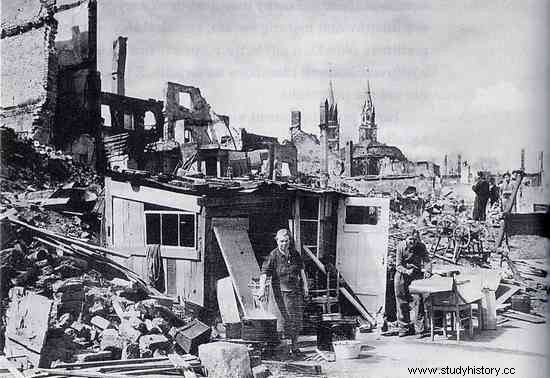Nuremberg, a place inextricably linked with the brown regime. It was there that the gigantic parteitagi took place, the notorious racial laws were announced, and finally, in the local court, the tribunal debated before the greatest Nazi criminals. Few, however, realize how much effort went into making Nuremberg the Nazi "ideal city".
The first stage was the construction of a number of new monumental edifices on the outskirts of the city. The most impressive of them was the Deutsches Stadion. Huge horseshoe-shaped sports arena, which, when completed , could accommodate up to half a million people !
It would be the largest structure of this type in the world - and that was what Hitler had in mind, who planned that when the Third Reich conquered the world the stadium would become a permanent venue for the Olympic Games . Each Olympics in turn…
Ancient architectural secrets and dowsers
The whole structure was supposed to overwhelm with its size and interestingly - unlike similar objects designed at that time - it referred to Greek and Roman patterns. As a result, the viewers were not only passive observers, but also created the entire spectacle. As Sidney D. Kirkpatrick writes in his book "Hitler and the Sacred Insignia":
The principle that determined the layout and proportions of the building was a peculiar mixture of panache, pathos, spectacularity and vague mysticism. Scientists from the Ahnenerbe [they studied the heritage left by the Aryan ancestors of the Germans - the author's footnote.] they supposedly discovered secret rules by studying ancient treatises and architectural masterpieces.

This is what the Deutsche Stadion was supposed to look like. When completed, it was to accommodate half a million people. Model from 1938
For example, the stand from which Hitler was to speak to the gathered crowds was modeled on the Hellenistic Pergamon altar, and the dowsers decided about its location and height! They found that it should be moved several hundred meters to take advantage of the beneficial effects of a strong magnetic field allegedly creating underground watercourses.
The builders of the stadium - whether they wanted to or not - had to comply with these "discoveries", despite the fact that it was associated with considerable difficulties, in the form of draining the pond and changing the route of the railway line. Well, but what is not done for the beloved Führer.
Of course, it's not over yet. The shape of the project - as Kirkpatrick writes - was influenced by many other peculiar beliefs and principles of "sacred geometry". The manifestation of this was, for example, twelve roads crowned with twelve columns, which were to connect the Nuremberg old town with the new complex of buildings and the parade square.
They were designed with the "magical" properties of the twelve in mind, related to the number of apostles and the twelve signs of the zodiac. Also the symbol of the "Black Sun" - a triple swastika inscribed in a circle - which was placed on many buildings, referred to this theory.
As Kirkpatrick notes, the architects' thinking was also governed by another principle. All buildings, as far as possible, were to be facing north, towards the legendary land of Thule [alleged cradle of the Aryans - author's note] .
As if that were not enough, the Deutsche Stadion resembled the Odeon of Herod Attic in Athens. This was because the leader of the "Thousand-year-old" Reich was convinced that the ancient buildings had survived for hundreds of years thanks to the power they contained resulting from the use of secret rules and formulas. Well, but here the Austrian corporal miscalculated a lot. The stadium was never even finished and what was built is now overgrown with forest ...
Time to start the reconstruction of Nuremberg
However, the Nazis did not limit themselves to creating the "new" Nuremberg. They also started redeveloping the old town. Their goal was to confirm the arrival of the great brown era and to portray Hitler as as a true guardian, protector and restorer of the informal capital of the Holy Roman Empire.
The first step was to "clean" the old town of everything that spoiled the perfect image of a medieval city. Therefore, signs and advertisements were removed, flat roofs were replaced with sloping ones, which were covered with tiles, and plasters were also chipped, revealing stone walls and wooden elements of the structure.

In addition to building new facilities, the Nazis devoted much attention to the Old Town of Nuremberg. Most of the work was put into the renovation of the local castle. However, instead of taking care of historical fidelity, the Germans simply created a fairy-tale castle
The oil stage was the demolition of buildings of no historical value. When this was done, new ones were erected in their place, imitating the style of the old buildings. On this occasion, all traces of Jewish and Slavic influence were removed from the city.
The largest of the projects carried out within the old town was the reconstruction of the post office located at the very market square. As Kirkpatrick writes:
has been identified as an "unacceptable foreign body" disfiguring the city's medieval buildings. The façade of the building was completely changed and the roof was replaced with a gable roof to match the style of the neighboring buildings. The front wall of the building also features medieval anti-Semitic wall paintings.
In addition, the town hall and the hospital of St. Spirit and the Church of St. Lawrence, which was to become the national cathedral of the Third Reich in the future.

Despite the enormous effort that went into making Nuremberg the fairy-tale city of Hitler, not much of it remains to this day. The city suffered a lot during the carpet raids. The photo comes from the book "Hitler and the Sacred Insignia" by Sidney D. Kirkpatrick (WL, 2012)
Much attention was also paid to the Nuremberg Castle, which was to be cleared of 19th-century architectural elements. This was to restore its medieval appearance, symbolizing the greatness of the Holy Roman Empire of the German Nation. There was only one problem:no one really knew what the castle looked like in the Middle Ages, because - like many buildings of this type - it was constantly rebuilt.

The article is based on the book by Sidney D. Kirkpatrick, "Hitler and the Holy Insignia" (WL 2012)
But as the saying goes, nothing is difficult for a wanting person. Instead of cherishing historical allegiance, the Nazis simply created a fairy-tale fortress. What seemed to be too small was demolished, a few spiers, a vaulted entrance, battlements and drawbridges were added, and everything was ready. Hitler had his feste Burg.
It was all in vain. Nuremberg suffered a similar fate as many other cities of the "Thousand-year-old" Reich, which fell victim to carpet raids. The next destruction was caused by the fierce battles for the city fought by the Americans.
The scale of the damage is evidenced by the fact that about 130,000 buildings stood in Nuremberg before the war. After the conflict ended, 67,000 were completely ruined, 16,000 were partially demolished, and 30,000 were severely damaged. As a result, there is not much left of Hitler's fairy-tale city.
Source:
- Sidney D. Kirkpatrick, Hitler and the holy insignia , Wydawnictwo Literackie, 2012
